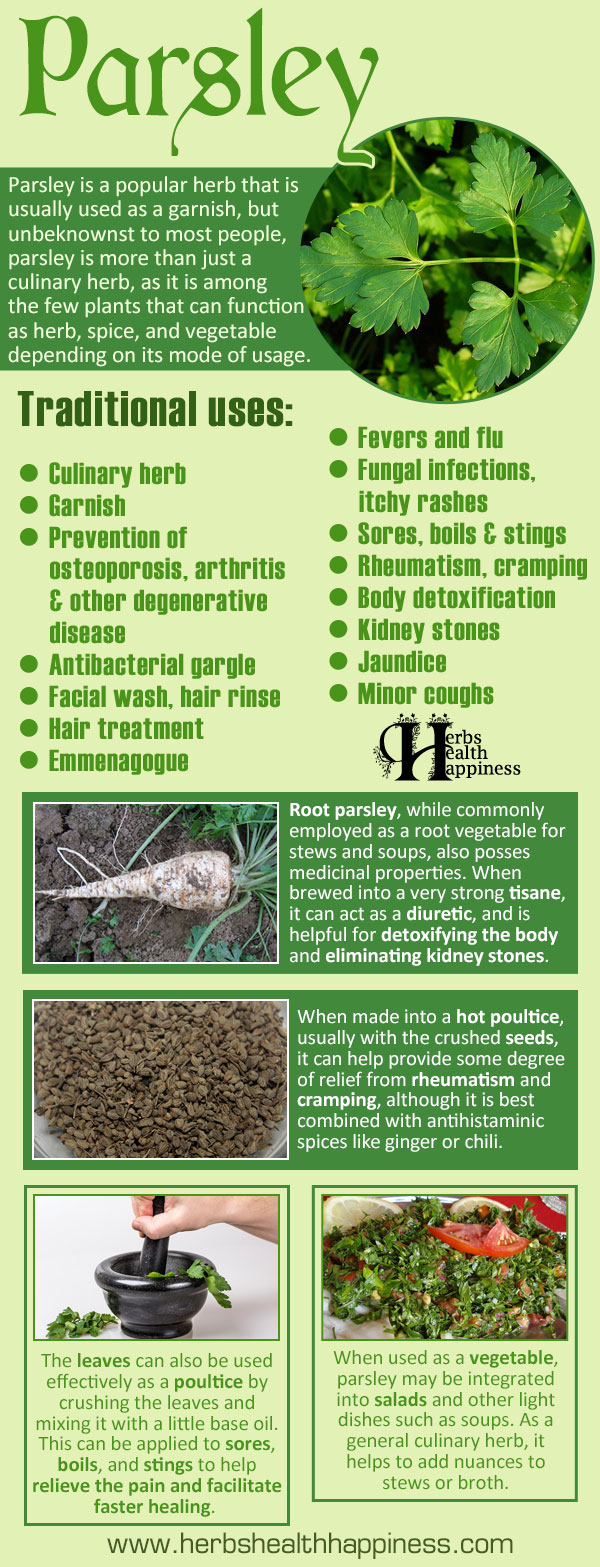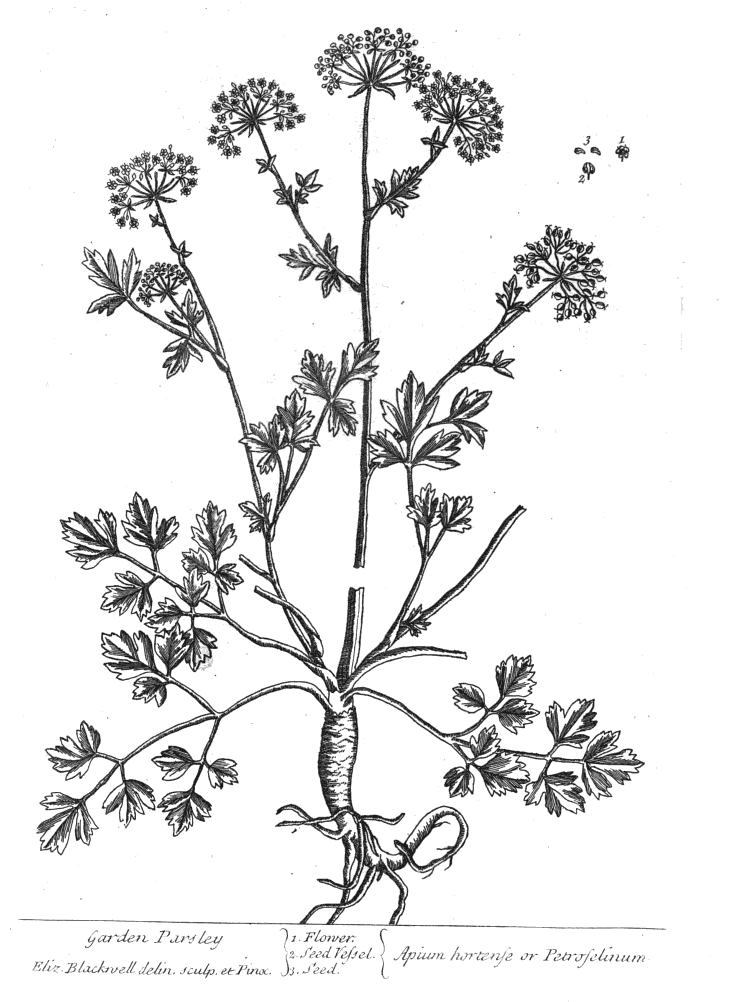Parsley

Parsley Uses and Benefits - image to repin / share
Infographic: herbshealthhappiness.com. Image credits: See foot of article

Names of Parsley, Past and Present
Greek: petroselinum (lit. 'rock celery')
Italian: bersomello / persil
French: peresil
Russian: petrushka (note - the word 'petrushka' is also the name of a Russian puppetry character)
Hebrew: karpas / Petersilia
Old English: Petersilie / Peresil
English: parsley / rock celery / curly leafed parsley / flat-leaf parsley
Latin (esoteric): petrocilium / petrosillum
Latin (scientific nomenclature): Petroselinum crispum (other nomenclatures exist, depending on the varietals)
Parsley - Botany And History
Parsley is a popular herb that is usually used as a garnish, but unbeknownst to most people, parsley is more than just a culinary herb, as it is among the few plants that can function as herb, spice, and vegetable depending on its mode of usage. Thought to be native to the Mediterranean, the use of parsley dates back to as far as circa 2000 B. C., where it was employed by the Ancient Greeks as a culinary, medicinal, and ritualistic herb. [1]

Parsley
Image source -
https://en.wikipedia.org/wiki/File:Petroselinum_crispum_003.JPG - CC
There are usually two very distinct and popular varietals of parsley – the curly leafed and the flat-leafed varieties, although there is one unique type of parsley that functions more as a root crop cum-spice than it does as an herb – root parsley. While not as 'ancient' as its leafy variety, root parsley also has a coloured history, although it is chiefly relegated to the culinary and the occasional medicinal associations.
All parsleys are typically characterised by their uniquely shaped leaves which either turn into themselves (curl), or otherwise lie flat. However their immediate appearance, parsley is mostly well-known for the distinct 'trident' or 'forked' like shape of its tiny leaves and its highly discernable earthy, bordering on grassy aroma. Other varietals of parsley, such as the root parsley typically possesses thicker stems, more pronounced less curly leaves, and comparatively milder aromas.

Parsley - Herbal Uses
Whenever the word 'parsley' is heard, the most common association with this pungent herb evokes culinary overtones, as parsley is typically employed either as a spice for cooking, or as a garnish for dishes. Parsley works well when employed as an herb or a spice, especially if incorporated into meaty or gamey dishes like beef, lamb, goat, and venison. When used as a vegetable, parsley may be integrated into salads and other light dishes such as soups. As a general culinary herb, it helps to add nuances to stews or broth.
Parsley can also be used medicinally when made into tisanes. Tisanes made from parsley can be used to treat a number of different diseases, although they act more as a preventative than it does a cure. Parsley is chock-full of potent active compounds, among them a slew of antioxidants and vitamins (such as folate and trace amounts of Vitamin C, K, and A) which not only prevent aging, but can effectively reduce the possibility of complications that may arise due to old age, or due to a long-standing hereditary propensity for specific types of illnesses. [2]
Drinking a mild decoction of fresh parsley, or integrating it into one's diet on a moderate but regular basis may help in the treatment and prevention of osteoporosis, arthritis, and other degenerative diseases and may even help to improve heart health. A very strong decoction of parsley may be used as an antibacterial gargle or mouthwash, or it can be employed as a facial wash or hair rinse to rid oneself of acne or dandruff. A very strong hair rinse made from parsley and a combination of other herbs such as basil and rosemary may also effectively help to thicken and darken hair.
Both root parsley and the herb parsley contain a volatile essential oil called apiol, which can be extracted through steam distillation. While the leaves contain significant amounts of the essence, it is the seeds of the plant that are usually employed for extraction, as it possesses the most significant amounts of the volatile oil. This essential oil can be diluted with a base oil and applied as a topical antifungal and antimicrobial agent, or otherwise diffused as an uplifting aphrodisiac scent. While most essential oils are dangerous when consumed, a minimum of five drops of parsley's essential oil mixed with warm water makes for an excellent emmenagogue. [2] The whole seeds itself can be crushed or bruised and subsequently decocted and drunk as a remedy for fevers and flu. The leaves, when employed in its dry state, may also be sewn into cloth bags and employed as a bathing sachet to help smoothen skin and cure fungal infections and itchy rashes. [3]
The leaves can also be used effectively as a poultice by crushing the leaves and mixing it with a little base oil. This can be applied to sores, boils, and stings to help relieve the pain and facilitate faster healing. This detoxifying nature also extends to treating minor poisonous bites like scorpion or wasp stings. [3] When made into a hot poultice, usually with the crushed seeds, it can help provide some degree of relief from rheumatism and cramping, although it is best combined with antihistaminic spices like ginger or chili.
Root parsley, while commonly employed as a root vegetable for stews and soups, also posses medicinal properties. When brewed into a very strong tisane, it can act as a diuretic, and is helpful for detoxifying the body and eliminating kidney stones. When combined with parsley leaves, it can be drunk as a daily tonic, and can be helpful for curing jaundice and minor coughs.
Parsley - Esoteric Uses
In magickal practice, parsley is usually employed as a common ingredient in 'fixing' spells and love potions, while the dried leaves, when burnt as incense, is usually employed as an offering to deities, or as a facilitator for necromantic rites and astral travel. [4] Tisanes made from parsley are said to encourage fertility, while bath water scented with its essential oil or otherwise steeped with parsley was said of old to incite lust and desire.
References:
[1] https://en.wikipedia.org/wiki/Parsley
[2] https://www.whfoods.com/genpage.php?tname=foodspice&dbid=100
[3] https://botanical.com/botanical/mgmh/p/parsle09.html
[4] https://www.gardensablaze.com/HerbParsleyMag.htm
Parsley Illustration

Parsley
Article researched and created by Alexander Leonhardt,
© herbshealthhappiness.com
Infographic Image Sources:
Pixabay (PD)
https://commons.wikimedia.org/wiki/File:Petroselinum_crispum_003.JPG
https://en.wikipedia.org/wiki/File:Wurzelpetersilie_Wurzel.jpg
https://en.wikipedia.org/wiki/File:%D8%B5%D8%AD%D9%86_%D8%AA%D8%A8%D9%88%D9%84%D8%A9.JPG
https://en.wikipedia.org/wiki/File:Parsley_seeds(%E0%A6%B0%E0%A6%BE%E0%A6%A7%E0%A7%81%E0%A6%A8%E0%A6%BF).JPG
(Creative Commons)


1. Famous Chef Sheds 60lbs Researching New Paleo Recipes: Get The Cookbook FREE Here
2. #1 muscle that eliminates joint and back pain, anxiety and looking fat
3. Drink THIS first thing in the morning (3 major benefits)
4. [PROOF] Reverse Diabetes with a "Pancreas Jumpstart"
5. Why Some People LOOK Fat that Aren't
6. Amazing Secret Techniques To Protect Your Home From Thieves, Looters And Thugs
7. The #1 WORST food that CAUSES Faster Aging (beware -- Are you eating this?)
If you enjoyed this page:


























